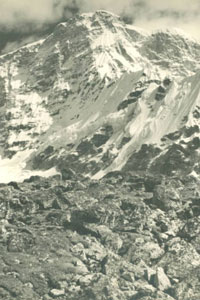1954 Nepal Expedition Video
In 1954 my father decided to return to Sikkim. This time however he decided to take some time away from preparing for his expedition – sherpas, equipment and provisions – and explore the many sights and sounds of Darjeeling.
Darjeeling is the queen of all the Himalayan hill stations. It had been the gift of the British Raj to India. The original name Dorje-ling used to belong to the kingdom of Sikkim. It became a very popular place and started to attract better facilities, hotels and other infrastructure. It also offered the visitor a chance to see a wide variety of peoples from the Himalayan regions. These included Tibetans, Nepalese, Sikkimese, Bhutanese and the Lepchas. Because of its location, its spectacular scenery, pleasant climate and clean air, Darjeeling started to also acquire a permanent European population, including Christian missionaries from every corner of the earth. These missionaries – the Belgians, the British, the Irish and North American - built and ran the great schools that can be found in Darjeeling.
Darjeeling became quite a place and even the West Bengal government moved parliament to an imposing Government house located here when the temperature in Calcutta became unbearable. And, of course, Darjeeling became the centre of the Indian tea industry where, arguably, some of the finest and best black tea in the world is grown. The English and Scottish tea planters owned, managed and operated the tea gardens. With all these diverse groups of people in Darjeeling, the town also developed its own expatriate life style.

Close-up view of Janak Chuli 7035m (formerly known as Outlier Peak) in centre foreground
But Darjeeling had another claim to fame. High altitude climbing and trekking expeditions used Darjeeling as their starting point into Sikkim and Nepal. Kangchenjunga, third highest mountain in the world and only 40 kilometres distant, with its massive outline dominated the skyline in Darjeeling. Its majestic form, in many ways, resembled a bookend for the eastern end of the Himalayan chain. The mountaineering expeditions assembled in Darjeeling, got their permits if required. They recruited their sherpas and porters here and obtained all their provisions here. It is no wonder that Darjeeling became a magnet for mountaineers and trekkers.
My father went to Ghum to see the Gurkha Festival that took place in a central fairground area. The Nepalese Gurkhas walked and danced in procession around central fairground area. The dancers in front are Gurkhas dressed as women. The women were regaled in their traditional costumes. The ceremonies opened with offerings and then animals – goats - were sacrificed culminating in the sacrifice of a cow with kukris, the famous Gurkha knife. But her they had to decapitate the heads of the animals with a single blow.
My mother and father came in October every year to visit me for the Durga Puja holidays when I attended North Point, a Jesuit boarding school. In various parts of India, Hindus celebrated Durga Puja, an annual Hindu festival and primarily dedicated to the Hindu goddess Durga, but other deities such as Shiva, Ganesha, Lakshmi and Saraswati were also drawn into the celebrations. Durga Puja was a popular festival, celebrated in October in Bengal over a ten-day period. Here, my father managed also to witness dome of the Durga Puja celebrations in Darjeeling.
The trek made its way to Sandakphu, one of many starting points for expeditions in the region. The trail in parts was rocky and challenging. They again established a campsite at an unidentified place with a Dak bungalow and scattered farmers houses. They proceeded along a valley until they were in the vicinity of the eastern flank of Kangchenjunga and the Jannu glacier.
During this part of the trek, they were surrounded by many famous Himalayan peaks – Kangchenjunga, Jannu – as well as many unidentified peaks. They also came into contact with some of the residents in the area – chowkidars, farmers and Tibetan herders with their families.
Eventually they made their way back to Darjeeling via the Singalila ridge and Sandakphu.
The film record of the 1952 expedition was made with a 16mm Paillard Bolex movie camera using Kodak colour film.
